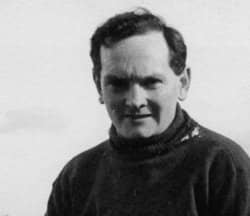
It was raining on Saturday so I took it as a good excuse to quit raking and shoveling leaves and watch the DVD of Deep Water again. If you haven’t seen it, I would give it a whirl. It’s a good documentary about the Sunday Times Golden Globe Race, 40 years ago. The focus is on the tragic tale of Donald Crowhurst. The interviews with his wife, son and best friend are very moving.
With the Vendee Globe in full swing, it struck me what an incredible revolution that sailing has undergone in the last 40 years. I blogged about it before when Joyon completed his incredible 54 day circumnavigation. It’s worth taking a look at the differences.
The Prize: The Vendee Globe has one winner – fastest time. The racers in the Golden Globe were sailing for two prizes- First home and fastest time. RKJ as the only sailor to complete the race won both.

The Course: For all intents and purposes the course hasn’t changed much. The main differences are that the Vendee starts in the Sables D’Olonnes, a few hundred miles south of the start of the Golden Globe off the Southwest coast of England. Secondly, the Vendee racers will go further South than in the Golden Globe but it’s essentially the same bloody terrifying course: South to Cape of Good Hope, through the Roaring Forties for most of the race, a dip South around Cape Horn, then left turn for home.
The biggest difference is that all racers in the Vendee started at the same time, crossing the start line on November 9th, timed so that the race will take place during the Austral summer for obvious reasons. In the Golden Globe, the racers had to start between June 1st and October 31st. The racers were spread far and wide around the globe until the closing month. At about this time forty years ago, Robin Knox-Johnston on Suhaili would have been East of Australia when Donald Crowhurst would be somewhere in the Northern Atlantic.
The Boats: This is where the difference is most striking. In the Vendee Globe, the racers sail Open 60s. All 59-60 feet long monohulls with similar rigs. Most of the boats have carbon fiber hull and masts, Kevlar sails and an incredible array of communications and navigation technologies. The boats are evenly matched.
Forty years ago, the contrasts could not have been more dramatic. The 9 boats ranged from seasoned blue-water monohull cruisers to freshly built, innovative trimarans. Moitessier‘s Joshua was a relatively sleek, steel speed-machine that surfed the big waves in a storm. RKJ’s Suhaili was a 32 foot teak ketch. Suhaili weighed as much as one of today’s Open 60s although about half the size. Chay Blyth and John Ridgway sailed small weekend cruisers. Not surprisingly neither made the circumnavigation.
As for technology, forty years ago it was a radio, a magnetic compass, a sextant, a log, a log book, the all-important wind vane steering auto helm and that was about it.
The biggest difference is speed. The Open 60s will take about 90 days to make the circumnavigation. RKJ took 313 days to make the same 28,000 miles. RKJ’s average speed 3.39 kts. The Open 60s will average 15+ kts. Can anyone think of any other mode of transportation that has evolved as significantly in 40 years?
The Racers: Forty years ago, no one had sailed non-stop round the world. Francis Chicester had done it with a stop in Australia. The uncertainty that the 9 men faced in 1968 was incredible. Could they withstand the rigors and the psychological strain of 10 months at sea? In the end, RKJ was the only one who came out successful and unscathed. Moitessier was already a little close to nuts before he started and abandoned the race to keep going for another 6 months on a spiritual voyage of self-discovery. Tetley nearly completed the race but his boat sank. Tragically he killed himself 3 years after the race. Crowhurst’s story is well-documented. The other 5 sailors had abandoned much earlier – most before they rounded the Cape of Good Hope.
Forty years ago, no qualification was needed to participate. Although many of the racers were very experienced not all were up to the job. Crowhurst was a weekend sailor and Chay Blyth was reading a manual on how to sail as he left Southampton.
Now, all 30 competitors are essentially professional sailors. Most of the racers come from France and the UK as they did for the most part in the Golden Globe. In 1968, they were all men. It was unthinkable that a woman would take part. Today two of the competitors are women, following in the footsteps of Ellen MacArthur.
To participate in the Vendee Globe, a racer needs to have completed a Transatlantic race at least. They know what they are getting into and have the experience to deal with it. These days, the racers have two huge challenges – completing the race and raising the money to take part. Sponsorship is hard to come by and the cost of building, equipping and maintaining an Open 60 is gargantuan. In Peter Goss’s excellent Close To The Wind, it was clear that getting to the start was as big a challenge as completing a particularly tough race.
Don’t get me wrong, the 30 sailors in the Vendee Globe face an incredibly tough challenge. I couldn’t do it. The sophistication of their boats and the speed at which they sail make them all the more fragile as the early days of the race have already shown. To me though, the challenge they face today just reinforces what an incredible undertaking it was forty years ago and the awesome scale of RKJ’s feat in being the only sailor to complete the race.

great read; thanks!
We give you the greatest chance to catch fish and most adventure place in sea. To get more information. visit: http://www.CharterAndGuideFishing.com